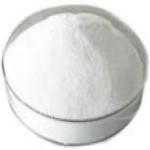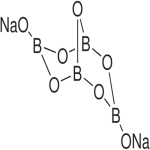CAS Number 1303-96-4, Borax or Sodium Borate USP NF BP Ph Eur Analytical Reagent Grade Manufacturers Exporters







CAS Number 1303-96-4, Borax or Sodium Borate Manufacturer Exporter
For Properties Specifications of Borax or Sodium Borate Click Properties, Specifications of Borax or Sodium Borate Manufacturer.
For Uses of Borax or Sodium Borate Click Uses of Borax or Sodium Borate Manufacturer.
For For SDS MSDS Sheet of Borax or Sodium Borate Click SDS Safety Data Sheet MSDS Sheet of Borax or Sodium Borate Manufacturer.
The Properties and Specifications of Borax or Sodium Borate:
Sodium Borate USP NF Grade Specifications
Sodium Borate USP-NF; Borax USP NF
Na2B4O7-10H2O 381.37
Borax
Borax CAS 1303-96-4]
Anhydrous 201.22 CAS 1330-43-4
Sodium Borate contains an amount of Na2B4O7 equivalent to not less than 99.0 percent and not more than 105.0 percent of Na2B4O7·10H2O.
Identification: A solution (1 in 20) responds to the tests for Sodium and for Borate.
Carbonate and bicarbonate: To 5 mL of a solution (1 in 20), contained in a test tube, add 1 mL of 3 N hydrochloric acid: no effervescence is observed.
Heavy metals: the limit is 0.002%.
Borax BP Ph Eur Grade Specifications
Borax BP; Sodium Borate; Sodium Tetraborate
Na2B4O7,10H2O -- 381.4 -- CAS 1303-96-4
DEFINITION
Borax contains not less than 99.0 per cent and not more than the equivalent of 103.0 per cent of disodium tetraborate decahydrate.
CHARACTERS
A white, crystalline powder, colourless crystals or crystalline masses, efflorescent, soluble in water, very soluble in boiling water, freely soluble in glycerol.
IDENTIFICATION
A. To 1 ml of solution S (see Tests) add 0.1 ml of sulphuric acid and 5 ml of methanol \ and ignite. The flame has a green border.
B. To 5 ml of solution S add 0.1 ml of phph solution. The solution is red. On the addition of 5 ml of glycerol (85 per cent) the colour disappears.
C. Solution S gives the reactions of sodium.
TESTS
Solution S: Dissolve 4.0 g in carbon dioxide-free water prepared from distilled water and dilute to 100 ml with the same solvent.
Appearance of solution: Solution S is clear and colourless.
pH: The pH of solution S is 9.0 to 9.6.
Sulphates: 15 ml of solution S complies with the limit test for sulphates (50 ppm).
Ammonium: 6 ml of solution S diluted to 14 ml with water complies with the limit test for ammonium (10 ppm).
Arsenic: 5 ml of solution S complies with limit test A for arsenic (5 ppm).
Calcium: 15 ml of solution S complies with the limit test for calcium (100 ppm).
Heavy metals: 12 ml of solution S complies with limit test A for heavy metals (25 ppm).
Sodium Borate Decahydrate or Borax Analytical Reagent Grade Specifications
Sodium Tetraborate Decahydrate
Na2B4O7 -10H2O
Formula Weight 381.37
CAS Number 1303-96-4
REQUIREMENTS
Assay: 99.5-105.0% Na2B4O7-10H2O
pH of a 0.01 M solution: 9.15-9.20 at 25C
MAXIMUM ALLOWABLE
Insoluble matter: 0.005%
Chloride (Cl): 0.001%
Phosphate (PO4): 0.001%
Sulfate (SO4): 0.005%
Calcium (Ca): 0.005%
Heavy metals (as Pb): 0.001%
Iron (Fe): 5 ppm.
The Uses of Borax or Sodium Borate:
Borax is used in Specialty toothpastes and mouthwashes, Cosmetics such as lotions, skin creams, moisturizers, sunscreen, and acne care products, Paint and ceramic glaze, Herbicides etc. It is also used in laundry detergents and household cleansers.
The MSDS-SDS Hazard Statement of Borax or Sodium Borate:
Borax or Sodium Borate Decahydrate SDS, Safety Data Sheet
MSDS Sheet, Material Safety Data Sheet 04-Jan-23
1. Product Identification
Product Name & Other Names: Sodium borate decahydrate or borax or sodium pyroborate.
CAS No.: 1330-43-4 (Anhydrous) 1303-96-4 (Decahydrate)
EINECS EC Number: 215-540-4
Molecular Weight: 201.22 or 381.37
Chemical Formula: Na2B4O7 or Na2B4O7.10H2O
Relevant uses and uses advised against (if any): Laboratory Chemicals and Industrial Manufacturing Use.
2. Hazards Identification
GHS, Globally Harmonized System Classification in accordance with 29 CFR 1910
Classification according to Regulation (EC) No 1272/2008
Serious eye damage/eye irritation Category 2A, H319
Reproductive toxicity Category 1A, 1B, H360
Labeling according to GHS & Regulation (EC) No 1272/2008
GHS Label Elements  Health Hazard |
Signal Words: Danger
Hazard Statements:
H319: Causes serious eye irritation.
H360: May damage fertility or the unborn child.
Precautionary Statements:
P201: Obtain special instructions before use.
P202: Do not handle until all safety precautions have been read and understood.
P264: Wash contaminated parts thoroughly after handling.
P280: Wear protective gloves/protective clothing/eye protection/face protection.
P281: Use personal protective equipment as required.
P305+351+338: IF IN EYES: Rinse cautiously with water for several minutes. P337+P313: If eye irritation persists get medical advice/attention.
P308+313: IF exposed or concerned: Get medical advice/attention.
P337+313: If eye irritation persists get medical advice/attention.
3. Composition/Information on Ingredients
Product Name & Other Names: Sodium borate decahydrate or borax or sodium pyroborate.
CAS No.: 1330-43-4 (Anhydrous) 1303-96-4 (Decahydrate)
EINECS EC Number: 215-540-4
4. First Aid Measures
Always seek medical attention after first aid measures are provided.
Inhalation: If Sodium Borate or Borax is inhaled, remove to fresh air. If not breathing, give artificial respiration. If breathing is difficult, give oxygen. Get medical attention.
Ingestion: Induce vomiting immediately as directed by medical personnel. Never give anything by mouth to an unconscious person. Get medical attention.
Skin Contact: Immediately flush skin with plenty of water for at least 15 minutes while removing contaminated clothing and shoes. Get medical attention. Wash clothing before reuse. Thoroughly clean shoes before reuse.
Eye Contact: Check for and remove any contact lenses. In case of contact, immediately flush eyes with plenty of water for at least 15 minutes. Cold water may be used. Get medical attention if irritation occurs.
5. Fire Fighting Measures
Fire: Not considered to be a fire hazard.
Fire Extinguishing Media: Use water spray, alcohol-resistant foam, dry chemical, or carbon dioxide. Use any means suitable for extinguishing surrounding fire.
Special Information: In the event of a fire, wear full protective clothing and NIOSH-approved self-contained breathing apparatus with full face piece operated in the pressure demand or other positive pressure mode. At high temperatures under fire conditions, it may produce toxic or irritating fumes. Fire-extinguishing work is done from the windward and the suitable fire-extinguishing method according to the surrounding situation is used.
6. Accidental Release Measures
Personal precautions, protective equipment, and emergency procedures: Ventilate area of leak or spill. Avoid breathing dust/fumes/gas/mist/vapors/spray. Use individual protective equipment (waterproof boots, suitable protective clothing, safety glasses, etc.). Do not approach facing the wind. Do not touch the spilled material.
Environmental precautions: Do not let the product enter drains, soil, or water sources.
Methods and materials used for containment Cleanup procedures and Storage: Contain spilled material. Cover with an inert, non-combustible absorbent material, (e.g. sand, earth, diatomaceous earth, vermiculite). Vacuum or sweep-up and remove to an approved disposal container. Finish cleaning by spreading water on the contaminated surface and allow to drain as per law.
7. Handling and Storage
Precautions for safe handling: Apply according to good manufacturing and industrial hygiene practices. Ensure proper ventilation. In case of insufficient ventilation, wear suitable respiratory equipment. Wash thoroughly after handling. Do not drink, eat, or smoke while handling. Avoid contact with skin, eyes, and clothing. Minimize dust generation. Avoid breathing dust/fumes/gas/mist/vapors/spray. Keep container tightly closed. Avoid ingestion and inhalation. Use individual protective equipment (waterproof boots, suitable protective clothing, safety glasses, etc.).
Conditions for safe storage, including any incompatibilities: Store in cool, dry, and ventilated area away from heat sources and protected from sunlight in tightly closed original container. Keep air contact to a minimum. Store protected from heat, sparks and ignition sources and incompatible materials. Avoid contact with skin and eyes. Avoid inhalation of dust/mist/vapor. Do not store with incompatible materials like acids, alkaloids, and metallic salts.
8. Exposure Controls/Personal Protection
Airborne Exposure Limits:
Sodium Tetraborate Decahydrate (1303-96-4)
USA ACGIH, ACGIH TWA (mg/m³), 2 mg/m³
USA ACGIH, ACGIH STEL (mg/m³), 6 mg/m³
Sodium borate USA (OSHA) TWA 10 mg/m3
Ventilation System: A system of local and/or general exhaust is recommended to keep employee exposures below the Airborne Exposure Limits.
Personal Respirators (NIOSH Approved): If the exposure limit is exceeded and engineering controls are not feasible, a full face piece particulate respirator (NIOSH type N100 filters) may be worn for up to 50 times the exposure limit or the maximum use concentration specified by the appropriate regulatory agency or respirator supplier, whichever is lowest.
Skin Protection: Wear impervious protective clothing, including boots, gloves, lab coat, apron or coveralls, as appropriate, to prevent skin contact.
Eye Protection: Use chemical safety goggles and/or full face shield where dusting or splashing of solutions is possible. Maintain eye wash fountain and quick-drench facilities in work area.
Other Control Measures: Maintain good housekeeping in work area. Handle in accordance with good industrial hygiene and safety practice. Wash hands after handling.
9. Physical and Chemical Properties
Appearance: White, gray, bluish or greenish white streaked crystals.
Odor: Borax is odorless.
Odor threshold: Not available.
pH: Alkaline
Relative density: Not available.
Boiling Point: 320C (608F) Loses water
Melting Point: 75C (167F)
Flash point: Not available.
Auto-ignition temperature: Not available.
Decomposition temperature: Not available.
Upper/lower flammability or explosive limits: Not available.
Vapor pressure: Not available.
Vapor density: Not available.
Evaporation rate: Not available.
Flammability (solid, gas): Not available.
Partition coefficient: n-octanol/water: Not available.
Solubility: 6g/100g water.
Viscosity: Not available.
10. Stability and Reactivity
Stability: Stable under ordinary conditions of use and storage.
Hazardous Decomposition Products: Toxic gases and vapors may be released if involved in a fire.
Hazardous Polymerization: Will not occur.
Incompatibilities: Acids, alkaloids, and metallic salts.
Conditions to Avoid: Incompatibles.
11. Toxicological Information
Hydrate: Oral rat LD50: 2660 mg/kg.
Investigated as a mutagen, reproductive effector.
Investigated as a reproductive effector.
Carcinogenic Effects: Not a reported carcinogen by IARC NTP ACGIH OSHA.
12. Ecological Information
Toxicity to fish: LC50 - Limanda: 74 mg/l - 96 h, EC50 Daphnia: 1085 mg/l
Environmental Fate: When released into the soil, this material may leach into groundwater.
This substance/mixture contains no components considered to be either persistent, bioaccumulative and toxic (PBT), or very persistent and very bioaccumulative (vPvB) at levels of 0.1% or higher.
13. Disposal Considerations
Whatever cannot be saved for recovery or recycling should be managed in an appropriate and approved waste disposal facility.
14. Transport Information
DOT USA, TDG Canada & ADR/RID Europe: Not controlled.
IMDG/IMO: Not controlled.
IATA/ICAO: Not controlled.
15. Regulatory Information
USA:
SARA 311/312: Chronic Health Hazard. See section 2.
California Prop. 65 Components: This product does not contain any chemicals known to State of California to cause cancer, birth defects, or any other reproductive harm.
16. Other Information
DISCLAIMER: The information and recommendations set forth herein are presented in good faith and believed correct as of the date hereof. It is compiled from various sources and it is not necessarily all inclusive nor fully adequate in every circumstance. In addition, these suggestions should not be confused with nor followed in violation of applicable laws, regulations, rules or insurance requirements applicable. This MSDS sheet is intended only as a guide to the appropriate precautionary handling of the material by a properly trained person using this product. Individuals receiving the information must exercise their independent judgment in determining its appropriateness for a particular purpose.
Anmol Chemicals & Pharmaceuticals Pvt. Ltd. is an off-shoot of Anmol Chemicals Taloja. It is located in MIDC Taloja and it is manufacturing pharmaceutical grades of API, Excepients, Food grade and Reagent grade chemicals. Anmol Chemicals & Pharmaceuticals Pvt. Ltd. is a several decades old group of companies, engaged in manufacturing, supplying, distributing, wholesale supplies for actual users, retail or small pack supplies for research and development chemicals, fine and speciality chemicals, pharmaceutical excipients, mineral fortifiers in chemically pure, Analytical reagent grade, IP BP USP Ph Eur EP JP and other pharmaceutical grade monograph including FCC Food grade chemicals and Nutraceuticals, Mineral Fortifiers at best prices.

Borax or Sodium Borate Structure
CAS Number 1303-96-4, Borax or Sodium Borate Manufacturer Exporter
ANMOL CHEMICALS & PHARMACEUTICALS Pvt. Ltd.
India, USA, Europe, UAE
TELEPHONE: +912223770100
Navi Mumbai, INDIA
e-mail: info(At the rate i.e. @)anmol.org
Copyright. 15-nov-24
We manufacture:
Glacial Acetic Acid Manufacturer

